Emily Chung, a PhD researcher at St John's College, University of Cambridge, has published new research challenging long-held assumptions about social segregation in Victorian Manchester. Using data from the digitized 1851 census, Chung mapped the residential patterns of people from different social classes in the city. Her findings appear in The Historical Journal.
Chung’s research indicates that the wealthier classes in Manchester did not exclusively reside in city center townhouses or suburban villas. “Manchester’s wealthier classes did not confine themselves to town houses in the city centre and suburban villas, as we’ve been led to believe,” Chung says. “I found doctors, engineers, architects, surveyors, teachers, managers and shop owners living in the same buildings as poor weavers and spinners.”
She used ordnance survey maps, commercial directories, and census data to link individuals to specific addresses. This process took eight months and involved identifying buildings using known landmarks. Chung categorized residents into six occupational classes ranging from professional occupations to unskilled laborers.
The study found that the commercial district in southwest Manchester was more socially diverse than residential areas to the north and east. Even in Ancoats—considered a major working-class slum—about 10% of residents belonged to wealthier employed classes. Citywide, working-class individuals made up an average of 79.3% of the population.
Chung also examined surrounding townships. Cheetham had a higher proportion of upper-middle-class residents, while Salford’s population mix closely resembled that of Manchester itself.
When analyzing individual buildings, Chung discovered that over 60% of those housing the wealthiest occupational classes also housed unskilled laborers. “This was a big surprise. I started with the city centre and I thought the pattern might end there but as I moved onto the next part of Manchester, I kept finding this mixing. The most exciting moment was discovering that one in ten people living in Ancoats, the notorious working-class slum, were middle-class.”
Chung suggests that while different classes lived close together, the design and maintenance of housing limited their interaction. Developers often converted buildings into subdivided tenements to maximize profit. “Manchester grew almost organically with very little regulation and developers were determined to make maximum profit from as little land as possible,” Chung says.
Middle- and upper-class households often occupied ground- and first-floor units, while poorer families lived in cellars. “Manchester’s housing experiment stacked multiple households one on top of another. Different classes were living so close together but walls, ceilings and different routines minimised interaction between them,” Chung says.
Chung argues that daily routines based on occupational status played a major role in social segregation. Wealthier individuals had more flexible schedules for shopping and leisure, while factory workers faced long hours with limited mobility. “While Victorian London and Liverpool bustled with daytime activity, Manchester’s public spaces were almost deserted. Its streets were rarely occupied by weavers and doctors at the same time,” Chung says.
Recreational habits also contributed to segregation. Middle classes increasingly attended church services with reserved pews for wealthier congregants. Working-class residents frequented pubs but faced policing intended to keep them out of public spaces dominated by the upper classes. “Even small groups of working-class men were made to disperse by officers on rotation,” Chung says. “They were determined to keep the city’s middle-and upper-class dominated public realm clear, clean and calm, so they forced the working poor out of sight into more neglected parts of the city.”
Chung concludes that perceptions about class segregation in Victorian Manchester do not always match the reality revealed by geographic data. “What the Victorians ‘thought’ was happening in Manchester still matters, but comparing these perceptions against concrete geographic patterns means we can reconstruct life in the city more accurately. Then we can understand how those perceptions arose.”
Chung is a member of the Cambridge Group for the History of Population and Social Structure (CAMPOP), which has researched family and social history for over six decades. Her PhD is funded by the Economic and Social Research Council (ESRC).
Reference: Emily Chung, ‘Proximity and Segregation in Industrial Manchester’, The Historical Journal (2025). DOI:10.1017/S0018246X25101246

